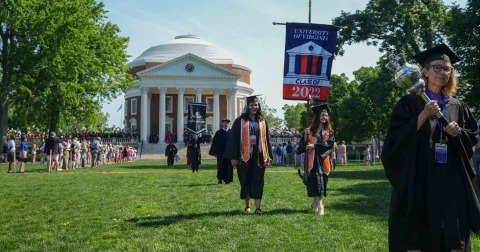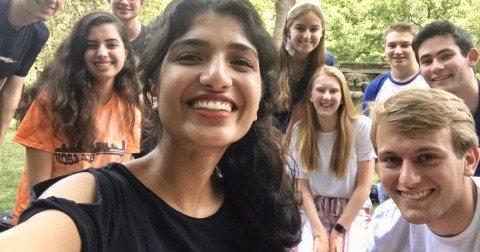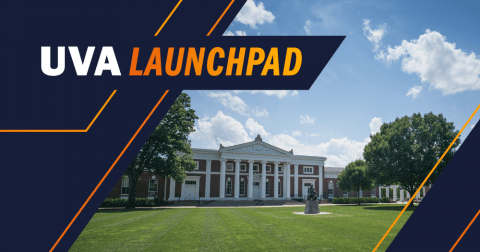Student researchers explore the Lawn for history of black students’ experience
A graduate student and an Arts & Sciences undergraduate conducted research in the University of Virginia’s historic Academical Village this summer, exploring the Lawn experience for black students and the history of the pavilion gardens.
Sophia McCrimmon, a third-year student double majoring in American studies and history with a minor in historic preservation, worked with Christian P.L. West, a doctoral student in UVA’s Curry School of Education and Human Development on a project that received research funds from the William R. Kenan, Jr. Endowment Fund of the Academical Village, which awards grants supporting students who conduct summer research projects that increase public understanding of the University’s original, Thomas Jefferson-designed precinct. The Kenan Fund provides recipients with up to $4,000 for their projects, with an additional $1,000 for a faculty adviser.
Already the holder of two UVA degrees, West received his bachelor’s in political and social thought from the College in 2009 and a Master of Education degree in 2017.
As a doctoral candidate, he aims to explore the experience of black alumni who were Lawn residents over four decades, and his study looks specifically at how they make meaning of their living-learning experience in the Academical Village, and how perceptions of their experience influence their racial identity and leadership development during their college experience.
“Given the Academical Village’s construction by enslaved laborers and the institution’s participation in segregation leading to the first black Lawn resident in 1961 [Amos Leroy “Roy” Willis], I argue that black residents of the Lawn will fundamentally have a differentiated experience,” said West, who is from Louisa, Virginia. “With the lack of empirical research on residents of the Academical Village, I hope to present a narrative of how black student leaders negotiate a path for student success during their time on the Lawn and in different eras of the institution.”
West himself was a Lawn resident in the 2008-09 academic year, at a time when students began to investigate the Academical Village’s construction by enslaved laborers, which eventually led to the President’s Commission on Slavery and the University and the Memorial for Enslaved Laborers.
West wants his research to fill a gap of empirical literature on the residential experience in the Academical Village, for both Lawn and Pavilion residents.
“While we know much about the Academical Village’s conception by Jefferson, we do not have much evidence on the day-to-day experiences of its most recent residents,” West said. “This study will document a crosssection of this population, black alumni Lawn residents, and provide a narrative of their experience while living on the Lawn.
“It will also highlight the present implications of the institution’s history with slavery and segregation to tell a fuller history of the Academical Village,” according to third-year student Sophia McCrimmon, who researched the social histories of the 10 pavilion gardens surrounding the Lawn.
“These unique spaces have a multifaceted history, from their original function as sites of enslaved labor to their contemporary role as landscaped gardens,” she said last spring. “Building upon existing scholarship on the evolution of the gardens’ built environment, I am interested in exploring their different social uses and cultural meanings — for enslaved laborers, professors, and their families, students, and others.”
McCrimmon has led historical tours with the University Guide Service.
“Like many other Guides, I take tourists to the gardens to discuss the history of slavery at UVA,” she said. “I was struck by the dissonance of discussing such difficult histories in such aesthetically beautiful spaces, and it prompted me to do more research on the layered history of the gardens. I’m intrigued by how the spaces have historically functioned as both public and private places which are both beautiful and utilitarian. I would love for my research to complicate our understanding of these spaces, exposing their multifaceted history.”
McCrimmon is using the work of 2008 Kenan Fellow Lydia Mattice Brandt as the foundation for her research. Brandt examined the 19th-century history of the gardens. An Echols Scholar and a Jefferson Scholar, McCrimmon is considering pursuing a graduate degree in American studies and hopes to do public history work.
McCrimmon said she was drawn to the Kenan Fellowship because of its emphasis on the shared history of the Academical Village and its focus on a public-facing research product.
“This really aligns with my passion for UVA’s public history,” McCrimmon said. “I’m hoping that I can connect this research to my work with University Guide Service and the President’s Commission on Slavery and the University, using it to deepen our public understanding of the garden spaces.”






















